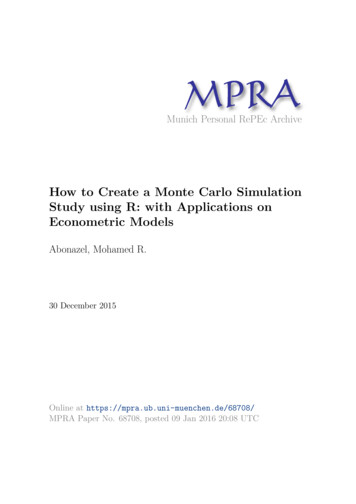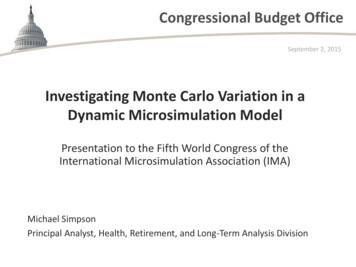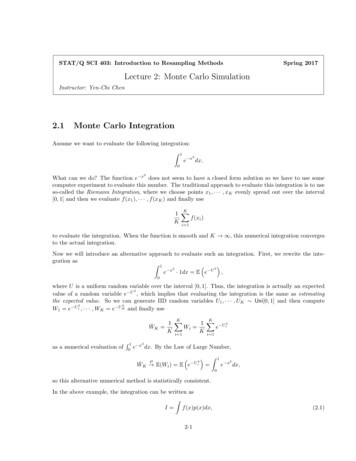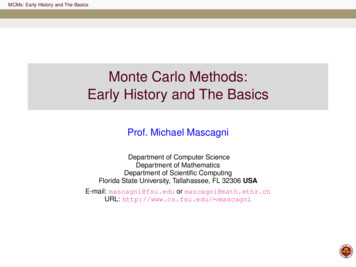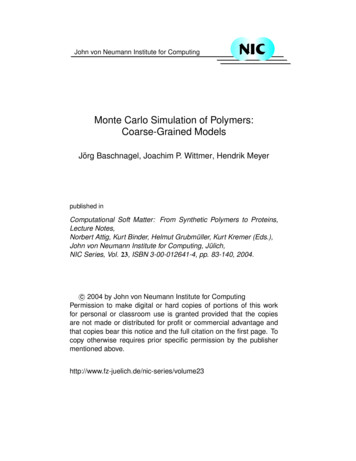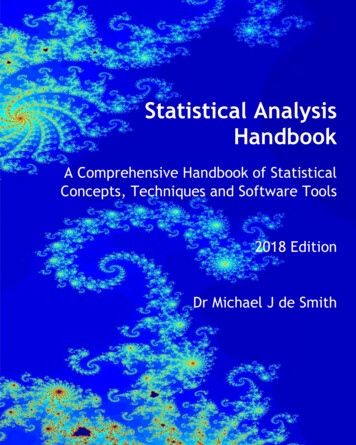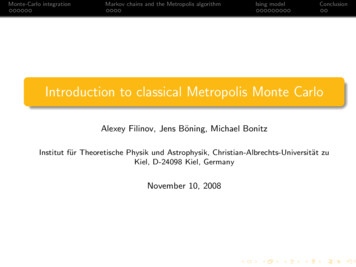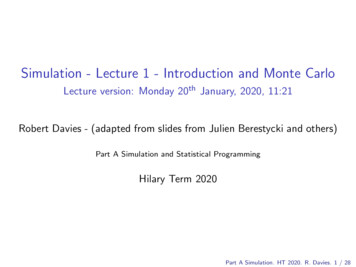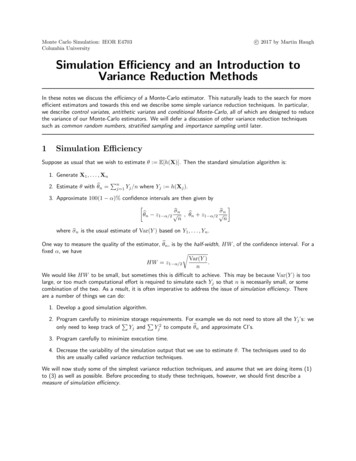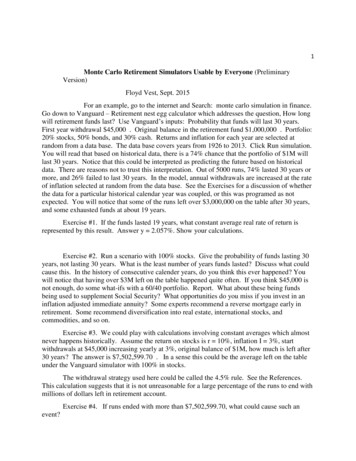
Transcription
1Monte Carlo Retirement Simulators Usable by Everyone (PreliminaryVersion)Floyd Vest, Sept. 2015For an example, go to the internet and Search: monte carlo simulation in finance.Go down to Vanguard – Retirement nest egg calculator which addresses the question, How longwill retirement funds last? Use Vanguard’s inputs: Probability that funds will last 30 years.First year withdrawal 45,000 . Original balance in the retirement fund 1,000,000 . Portfolio:20% stocks, 50% bonds, and 30% cash. Returns and inflation for each year are selected atrandom from a data base. The data base covers years from 1926 to 2013. Click Run simulation.You will read that based on historical data, there is a 74% chance that the portfolio of 1M willlast 30 years. Notice that this could be interpreted as predicting the future based on historicaldata. There are reasons not to trust this interpretation. Out of 5000 runs, 74% lasted 30 years ormore, and 26% failed to last 30 years. In the model, annual withdrawals are increased at the rateof inflation selected at random from the data base. See the Exercises for a discussion of whetherthe data for a particular historical calendar year was coupled, or this was programed as notexpected. You will notice that some of the runs left over 3,000,000 on the table after 30 years,and some exhausted funds at about 19 years.Exercise #1. If the funds lasted 19 years, what constant average real rate of return isrepresented by this result. Answer y 2.057%. Show your calculations.Exercise #2. Run a scenario with 100% stocks. Give the probability of funds lasting 30years, not lasting 30 years. What is the least number of years funds lasted? Discuss what couldcause this. In the history of consecutive calender years, do you think this ever happened? Youwill notice that having over 3M left on the table happened quite often. If you think 45,000 isnot enough, do some what-ifs with a 60/40 portfolio. Report. What about these being fundsbeing used to supplement Social Security? What opportunities do you miss if you invest in aninflation adjusted immediate annuity? Some experts recommend a reverse mortgage early inretirement. Some recommend diversification into real estate, international stocks, andcommodities, and so on.Exercise #3. We could play with calculations involving constant averages which almostnever happens historically. Assume the return on stocks is r 10%, inflation I 3%, startwithdrawals at 45,000 increasing yearly at 3%, original balance of 1M, how much is left after30 years? The answer is 7,502,599.70 . In a sense this could be the average left on the tableunder the Vanguard simulator with 100% in stocks.The withdrawal strategy used here could be called the 4.5% rule. See the References.This calculation suggests that it is not unreasonable for a large percentage of the runs to end withmillions of dollars left in retirement account.Exercise #4. If runs ended with more than 7,502,599.70, what could cause such anevent?
2Exercise #5. On the Vanguard page, click on What is Monte Carlo Simulation? In thefirst example, they give an average annual rate of return of about 12%. Gather their input dataand mark the graph with years and millions of dollars. You will notice that the balance after 30years was about 6,400,000 . They didn’t report an average inflation rate I. Calculate orestimate I. Give the real rate of return. Give a formula for the balance for years 1, 2, , 30 andgraph the balance in the fund. We estimated I 3% and a final balance of 6,327,723 after 30years. How does this compare to Vanguard’s graph?Exercise # 6. The second example gives a different graph of portfolio balance duringretirement. Gather the input and mark the graph in years and millions of dollars. Whathappened in the first two years? Assuming 3% constant average inflation, estimate the balanceat the end of year 1, at the end of year 2.Exercise #7. The third example presents yet a different graph of balance in the fund.Gather the input data and mark the graph in years and millions of dollars. What is theapproximate final balance? In both cases, what was the average rate of return? Using I 3%,what was the portfolio balance after year 1 and after year 2?Exercise # 8. They report an 80% survival. What proportions of stocks, bonds, and cashdid they use to get 80%? Give some portfolios of stocks, bonds, and cash 0% which have abetter survival rates. Examine 90/10; 80/20; 70/30; 60/40; 50/50. Which portfolio would youprefer and why? Did different sets of 5000 runs on the same scenario give different results?Exercises: Show your work. Label answers, variables, and numbers. Write in completesentences when appropriate. Draw graphs roughly or print graphs. Label axes and units.#9.Summarize the indexes used to represent stocks in the portfolio. Why did they usedifferent indexes? Do you think the history went back to a period which will not be repeated?#10.Summarize the indexes used to represent bonds in the portfolio.Discuss.#11. What was used for annual returns on cash? What would you suggest for the layout of thedata base and its data to be used with a random number generator for a Monte Carlo simulation?#12.Do you think the simulation included total return, and compounded returns?#13. Using random number generators, how would you run a simulation which couplescalender year data? How would you design where coupling is not expected?#14.What assumptions are made in Monte Carlo retirement simulations?#15. Read two articles on the internet: “Odds-On Imperfection: Monte Carlo Simulation”, and“Using Monte Carlo Simulations in Financial Planning Software.” Use them to critique theVanguard retirement simulator. Is it not subject to some of the criticisms? List and discuss.Is it subject to some of the criticisms? Discuss. List 20 factors that affect preretirement planningand 20 factors that affect planning for and near the retirement years. Which makes the most
3sense, Monte Carlo simulations for preretirement, or Monte Carlo simulations for the retirementyears?#16. Discuss “potential market scenarios – up and down markets, of various lengths,intensities, and combinations. Discuss “30 years” in terms of retirement age, longevitypossibilities, living expenses for different age periods, the figure 45,000, and the figure 1M,etc. If a person has 1M in stocks, bonds, and cash, what is likely to be the value of their totalretirement assets including Social Security? A better way to ask this question is, how much isrequired to supplement Social Security? The 1M scenario is for 2015 dollars.#17. Assuming 3% inflation and -14.65% return for the first year and -26.47% for the secondyear, estimate the balance at the end of years 1 and 2. What happens to a person who runs aMonte Carlo simulation just before retirement, and retires just before these losses? In whatsuccessive calender years did these losses occur?#18. Assuming 3% inflation and 57.6% return for the first year and 31.6% for the second year,estimate the balance at the end of years 1 and 2. In what consecutive calendar years did the gainsoccur?#19.Write the main points of “What is Monte Carlo Simulation?”#20. Write a comparison of the penalty for outliving your money with that of dying withmoney. Give your recommendation.#21. Scott Burns reports John and Jane with 1M, 40,000 first withdrawal, 30 years, age 65,50% stocks, 50% bonds, a 95% chance that funds will last 30 years. Check his figures against aMonte Carlo simulation. (Denton Record Chronicle, Sept. 6, 2015)#22. In Scott’s article, John and Jane want to withdraw 60,000. Their financial plannerdutifully puts this into his Monte Carlo analyzer. He says, “Sorry that’s suicidal.” Check theseresults. Would you be impressed by a financial planner who had a Monte Carlo simulator?#23. Scott says withdrawing 68,750 every year for 30 years has a 95% chance of not runningout of money. Estimate a nominal rate of return for Scott’s 50/50 portfolio. Scott say John andJane may leave 2,250,000 behind. What constant nominal rate of return does this use? Youmay need to estimate, or use a general solver, or graph.#24. Scott says at 2% inflation, the 68,752 reaches a purchasing power of 40,000 at age 92.Check his figures. At 3% inflation it is down to 40,000 at what age? John and Jane think theywill need less when they are older. What well-known retirement strategy starts with 1M and 40,000 first withdrawal?#26. Retirement calculators at other sites. Popular sites are T. Rowe Price and Fidelity. Theywill require registration. One that doesn’t require registration is Retirement Calculator - CNNMoney. Go to this site and note the type of required input, the type of output, and theexplanations in fine print. The CNN calculator assumes for the first year, to pay out (85% ofcurrent income) less (Social Security). They assume the withdrawals starting at 85% of current
4income increases yearly at 2.3% inflation. They get their Social Security figures from ssa.gov.Put in age 66, retire at 67. Note that the individual lives to age 92 and retires at age 67. Thisretirement income is financed by purchasing an inflation adjusted immediate annuity using adiscount rate of 6%. It may be that the annuity pays to age 92. From the beginning of age 67 tothe beginning if age 92 is 25 years.We could conduct an exercise using the gross income of 45,000 from Vanguard. Wecalculate that in CNN current preretirement income is 52,941 since 85% of 52,941 45,000.But CNN allows 50,000 and 55,000 as preretirement income. Put in 55,000 as preretirementincome in the CNN calculator. Put in amount saved is 0 so we can interpret the “You willneed.” Put in savings rate of 1%. You will read that 410,226 is needed to finance theretirement.To estimate Social Security, go to ssa.gov and Search: Quick Calculator. Put in birth date6/15/1948. This gives age 67 in 2015. Retirement date 11/2015. Enter preretirement income of 45,000. You may read the Social Security benefit is 1443 per month or 12(1443) 17,299per year.Go back to the Vanguard retirement calculator and put in 25 years, 410,000 as portfoliobalance, and 45,000 – 17,292 which is approximately 28,000 as the first year payoutincreasing yearly at the historical rates of inflation. Put in 50% stocks, 50% bonds, and 0% cash.Run the simulator. Do you get 51% chance of success?Discuss the comparison of the two calculators. Calculate an estimate of the priceof the annuity. Calculate the price with 3% inflation. Try this figure on the Vanguard simulator.Check the internet for prices of immediate inflation adjusted annuities. Calculate the cost ofsuch an inflation adjusted immediate annuity which lasts forever. Check the average rate ofinflation from 1927 to 2013. Compare the different assumptions, inputs, calculations, andconclusions. How safe is the CNN calculator annuity? How can the insurance company sell theannuity at such a low price? Is it clear whether the annuity is for 25 years or 26 years or forlife?#27. Go to Retire Income Score Card: immediate annuities – CBS. Figure the cost of animmediate lifetime inflation adjusted annuity, which pays starting at 28,000 per year, for asingle male, a single woman, and a couple. Compare this to the CNN calculator. Read otherreferenced articles by the author of this site. Discuss.#28. Conduct interviews to see what major expenses, other than the usual cost of living,people have incurred. For example, one retired person had expenses: his daughter’s cancer cost 350,000, and another had a special school for his grandson 500,000. Would you pay for agrandson’s college education. Twelve percent of students work their way through college. Howmany millions of dollars would pay for major expenses during the retirement years?#29. An economics lesson for long term planning: devaluing currency, real rate of return, longterm bonds, China’s devaluation of currency, public private debt at 350 percent of GDP, the 250
5percent trigger. To learn more read Scott Burns, “Devaluing currency leads to prisoner’sdilemma,” Denton Record Chronicle, Aug. 30, 2015. Report.#30 See the article “The Monte Carlo Method and Random Number Generators,”Consortium 56, 1995, COMAP. Com. in the section of this course entitled Additional Articles onFinancial Mathematics or Related to Personal Finance. See the several references cited on thefirst page this referenced article. Do all of the Exercises. Report.#31. On Dec. 18, 2011, Scott Burns reported that TIPS (Treasury Inflation ProtectedSecurities) have been a good investment for many years, including a year-to-date return of morethan 10 percent. That good performance also means that they are richly priced in Dec. 2011.Recently, for instance, Bloomberg listed a TIP maturing in five years with a current coupon of0.125 percent selling at a premium. This means it provides a negative real return, even when youprincipal is adjusted upward for inflation. With a real rate of return of negative 0.8 percent, itwould be losing that amount to inflation. Do the math to check Scott’s calculations. Look up theinflation rate for 2011. See the article in this course “Comparing After Tax Returns on TIPsand I-Bonds. (Taken from “If you have assets, you can manage your tax rate,” Denton RecordChronicle, Dec. 18, 2011)Side Bar Notes:Some Monte Carlo Simulations: Allen Roth says “I’ve seen simulations run using a baseaverage return of 10% annually then adding a couple of percent to reflect the planner’s stockpicking ability. Other models have a default of volatility that could only exist in a world wherethe stock market would only lose no more than six percent in every one of forty years. What didAllen say about using stock returns that go back to 1927? What did he say about Monte Carlosimulation for the time before retirement? (Money Watch)More about women. If you visit the Twitter hashtag “I look like an engineer”, you’ll seethousands of photos of young women, all engineers, all cheerfully working to overcome thestereotype that only men are engineers. Today 47 percent of all medical students and 46 percentof all medical residents are women. (Scott Burns, “Granddaughter, car represents life’schanges,” Denton Record Chronicle, Aug. 23, 2015.) “Women have outnumber men in gainingcollege degrees for more than a decade.” (Scott Burns, Denton Record Chronicle, June 26,2011.)The VIX index – known as the fear gauge measures the volatility investors expect in thestock market is well below its historical average of 20. Today’s calm investors may be in for ashock. Money, Sept. 2015, pager 82. What has been the record of the stock market since Sept.2015? Report.Immediate annuities. For a female, who pays 100,000: starting at age 60, animmediate annuity pays 480(12) 5780 per year. An immediate annuity, starting at age 75pays 710(12) 8520 per year. An immediate annuity bought at age 60 and deferred to age 75
6pays 1385(12) 16,620 per year. What do you think? Report. For more information, see“The New Way to Get IRA Income,” Money, Sept. 2015, page 46. Report.Testing 401(k) participants on knowledge of financial mathematics. The survey askedfive questions covering compounded returns, the impact of inflation on purchasing power,diversification, tax savings of pretax contributions, and employer matching contributions. Theleast knowledgeable had an average equity allocation of 44.3% whereas the more knowledgeablehad 62.3%. The more knowledgeable, the more likely to diversify. They were less likely toencounter volatility. They have more retirement savings. ( AAII Journal, August 2015, p. 5)Some studies of teaching personal finance in high school show no success.Economic changes have little long-term impact on stocks. Bond prices are stronglycorrelated with economic changes. The economic factors studied were M2 money supply, ISMindex of manufacturers’ prices, outstanding consumer credit, housing permits, initial joblessclaims, and average manufactures’ workweek. Look up some of these terms on Wikipedia.org.Report. (AAII Journal, August 2015, p. 5)Increasing the survivability of your retirement funds. John Ameriks and others found adecade ago that converting a portion of your retirement assets into a life annuity could increasethe probability of portfolio survival. Another study has found that acquiring a reverse mortgageearly in retirement has the same affect. They found that net worth at the end of 30 years(remaining home equity and remaining retirement assets) was greater as often as three fourths ofthe time. Do you think Monte Carlo simulation was used in the study? (Scott Burns, “Reversemortgages: Their time has come,” Denton Record Chronicle, April 15, 2012)Postponing Social Security can make your retirement income more tax efficient. Onceyou start Social Security, certain income can trigger the taxation of Social Security. Thus thatincome is double taxed. (Scott Burns, “If you have assets, you can manage your tax rate,”Denton Record Chronicle, Dec. 18, 2011) See the articles in this course “Income Tax on SocialSecurity,” and “Delayed Social Security Retirement and Increased Benefits.”Required Minimum Distributions (RMDs) begin on Traditional IRAs and 401(k)s at age70.5. Scott Burns, Aug. 18, 2013 reported that a 50/50 portfolio earned 1.77% At that time. Fora person age 70, the RMD was 3.65% of balance. All of the withdrawal is taxed at theirmarginal income tax rate. After the withdrawal, the portfolio had shrunk by 1.88%. Forsomeone age 75, the RMD was 4.37% and funds would shrink by 2.6%. For age 80, fundsshrank by 3.58%. If this continues, the retiree might not have enough funds to live on. Theywould prefer to use other funds than the tax delayed qualified funds. In 2013, Scott reported thatin every year since 1998, a 50/50 portfolio shrank due to low returns and RMDs. This has notalways been the case. In 1985, the 50/50 portfolio earned 7.19%, so portfolios for these agesdidn’t shrink. For more information on RMDs, see the article in this course, “The RMD Strategyfor Retirement Income Withdrawals” and IRS publication 590. (“Why RMDs are a principalconcern,” Denton Record Chronicle, Aug 18, 2013) Explain how Scott calculates his RMDpercentages. What about the yearly accumulated affect? RMDs can change your tax bracket.You may be able to do a Roth conversion until you reach the age for RMDs.
7Most Americans own more home than they can afford. Owning a home free and clear atretirement is a goal for most people. Most do not achieve this. Today, most people approachingretirement find themselves owning more home than they will be able to afford when they retire.The metric for this is simple. If you have financial assets greater than the value of yourmortgage-free house, you have a shot at a reasonable retirement security. Your house is aconsuming asset. You need to pay real estate taxes, insurance, and repairs, not to mention otherexpenses. One recent survey found that only 20% of retires had total financial assets other thanthe home which was greater than the equity in their home. (Scott Burns, “Do you own the rightamount of home?” Denton Record Chronicle, April 20, 2014, page 2D)True or False? For e-textbooks, it is less expensive to print out the electronic versionthan to purchase the heftier hardcover from the bookstore. (“E-textbooks smart way to study,”Denton Record Chronicle, Aug. 8, 2015) What is your experience?More jobs are requiring empathy skills. Empathy tests can be given to employees andothers. Examples of empathy test questions are: How often have you helped a co-worker whomyou did not know especially well with an assignment when your knowledge was greater thanhis? Another example is, I have tender, concerned feelings for people less fortunate than me.Possible answers: Never, Seldom, Sometimes, Often, Always. Empathy scores among collegestudents is down 10%. (Fortune)Investing in stocks. Twenty percent think stocks are the best long-term investment.Thirty- seven percent believe they can meet their financial goals without stocks. Fifty- twopercent own stocks, down from 65% in 2007. (Money, Jan./Feb. 2014 p. 166)Umbrella insurance adds liability insurance to your homeowners and auto insurance.Liability risks are everywhere. The average jury award for vehicular accident is 306,000.That’s why experts advise to buy umbrella insurance. A one million dollar policy can be boughtfor about 250. They advise having insurance of two time your exposed net worth. Yourexposed net worth varies by state. Your wages and assets may at risk (though in some states,retirement funds, pensions, and your home are excluded). (Money, Jan./Feb., 2014, p. 40)BlackRock is a 4 trillion money manager that runs 7000 different investment strategies.You may know them by their iShares brand of ETFs. One type is enhanced index funds. Sometilt to stocks that are both value and small. Another is a beta strategy that attempts to capture themarket. Another is minimum volatility. Another is holding stocks in equal proportion instead bymarket cap. Another is contrarian underweighting stocks the crowd loves too much.Fundamentals are based on measures such as sales and dividends. Momentum stocks, based onrecent price increase where stock price is expected to do well at least for a period of time. TheirETFs usually have low expense ratios and are purchased like stocks. (Money, Jan/Feb. 2014,page 72)Variability is volatile. Since 1926, stocks were 3.5 times as volatile as bonds. At thetime of the 2002 and 2008 financial crises, stocks were 14 times as volatile as bonds. Go tofinance.yahoo.com and put in GSPC for history of the S&P 500. What is the distribution ofstandard deviation? See an article in the UMAP Journal at COMAP on this topic.
8References:At Comap.com:“The Monte Carlo Method and Random Number Generators,” Consortium 56, 1995, COMAP.Com. See the several references cited on the first page this referenced article.“Random Numbers”, UMAP Module 590, 1992, COMAP.com.See Monte Carlo simulations on EXCEL.In this course under Unit 3: Long-Term Financial Planning, there are five articles onsurvivability of retirement funds, some of which used Monte Carlo simulations. See thosearticles.For a free course in financial mathematics, with emphasis on personal finance, for upper highschool and undergraduate college, see COMAP.com. Register and they will e-mail you apassword. Simply click on an article in the annotated bibliography, download it, and teach it.Unit 1: The Basics of Mathematics of Finance, Unit 2: Managing Your Money, Unit 3: LongTerm Financial Planning, Unit 4: Investing in Bonds and Stocks, Unit 5: Investing in RealEstate, Unit 6: Solving Financial Formulas for Interest Rate. For about thirteen more advanceor technical articles, see the UMAP Journal at COMAP. The last section is Additional Articleson Financial Mathematics or Related to Personal Finance. In all, there are about eighty articles.
#14. What assumptions are made in Monte Carlo retirement simulations? #15. Read two articles on the internet: "Odds-On Imperfection: Monte Carlo Simulation", and "Using Monte Carlo Simulations in Financial Planning Software." Use them to critique the Vanguard retirement simulator. Is it not subject to some of the criticisms? List and .
